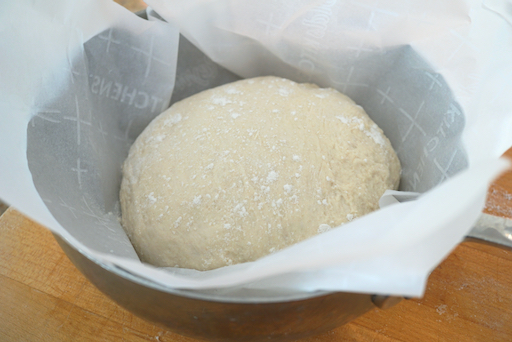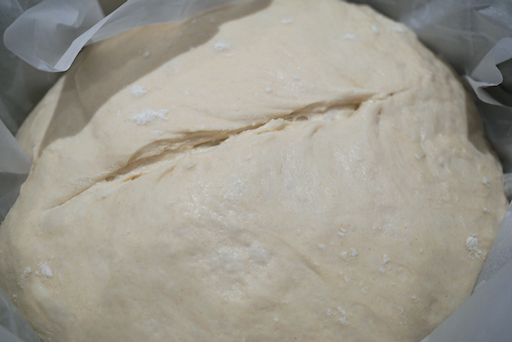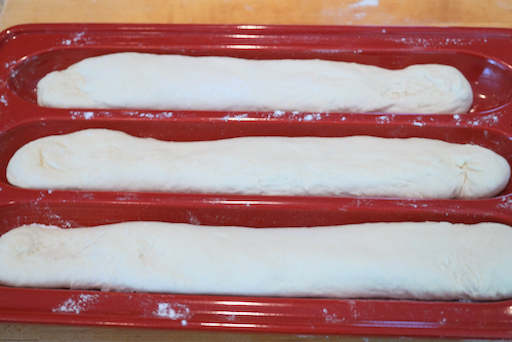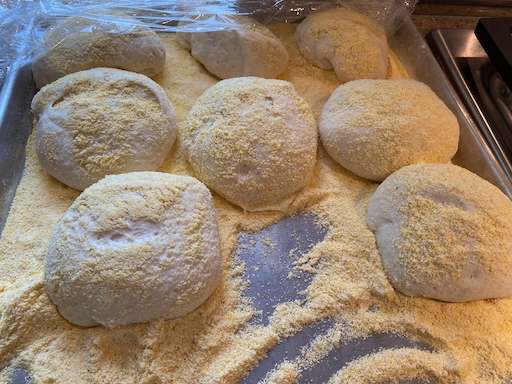My wife came across an article about using sour dough starter discards to make crumpets. Although we are not making sour dough starter (yet), making crumpets sounded interesting. We have never made them before and, to the best of our knowledge, nor have we ever eaten them. But they look like English muffins and our recent success making
English muffins encouraged us to make crumpets. Also, we happened to have English muffin baking rings. These rings did not work out so well with English muffins because the batter is so sticky, it is almost impossible to get it into the rings. But they are necessary for making crumpets because the batter is so runny it won't hold its shape without them. We found a few recipes on line and, we ended up combining two recipes. The cooking part is a bit tricky and we finally came up with a method by combining the two recipes.
Both sets of pictures show the second batch of crumpets toasted served like English muffins (two layers separated, see below "How to serve"). The first batch did not go so well. You can see the nice crunchy surface with all the little nooks and crannies that capture the melted butter.
Ingredients:
1 1/2 cups milk
3 1/2 cups all-purpose flour
1 1/4 teaspoons active dry yeast
2 teaspoons sugar
1 1/2 cups water (lukewarm)
1 teaspoon salt
1 teaspoon baking powder
Direction:
1. Warm the milk in a saucepan. Make sure that it is warm but not boiling (I was not sure how hot the milk should be but the milk gets mixed into the dry ingredients including the yeast. I reasoned that if it was too hot it would kill the yeast so I made sure the milk was about 110F.
2. Whisk together the warmed milk, flour, yeast, and sugar in a large bowl. (#2) I used a stand mixer with a paddle.
3. Once combined, add half the water and beat into the batter.
4. Continue to add more water until the batter is thick and smooth. Stop adding water once the batter reaches the consistency of thick cream. (I was not exactly sure what that consistency was, but I used up almost all the water so I decided that was enough).
5. Cover with plastic wrap and leave in a warm, draft-free place until foaming. This should take about 1 hour (#2). After one hour, it smelled very yeasty and looked bubbly.
6. Whisk the salt and baking powder into the batter (I added the salt in the dry ingredients).
How to cook (this is the most tricky part):
My wife carefully buttered the inside of the English muffin rings. Then, we melted the butter (my wife insisted it had to be butter not vegetable oil) in a large cast iron skillet on medium low flame. The recipe I was following suggested if the batter seeps out from the bottom of the ring, it is too watery; add more flour. Conversely, if the surface of the cooking crumpet does not form many little bubbles the batter is too thick, add more water. I started with one ring as a test. There was no seepage out the bottom (#3) and bubbles formed on the top. I concluded it was just right. So I went ahead and filled 4 rings (#4). The recipe said, fill the rings to just below the upper edge which I did. After a few minutes, the batter expanded and started running over the top edge of the rings. The recipe said to flip the crumpets over with the ring still on to cook the other side. This resulted in the excess batter going all over the bottom of the pan (#5). The crumpets were too thick and the center remained somewhat wet and doughy even after cooking them for over 20 minutes. This batch was deemed "a lack of success".
So, the next batch we adapted some ideas from the King-Arthur website recipe for crumpets. We filled the rings just half full (#6). After a few minutes, the batter expanded coming close to the upper edge of the rings (#7) (this looked much better than the previous batch). But for some rings, the batter did not come up to the upper edge, so flipping them with the ring still on would not have worked out well. The King Arthur recipe indicated that after 4 minutes cooking, as the edge of the batter dries out a bit the ring could be removed using a tong. We thought removing the ring would be difficult but as long as the batter did not expand to reach the top edge of the ring, it was surprisingly easy. We then flipped the muffin to cook the other side (without the ring) (#8). This worked much better than the method suggested in the previous recipe. We let the muffins cool on the cooling rack (the first picture above).
Tips for cooking:
1. Fill with batter to half height of the rings.
2. After 4 minutes, remove the rings using a tong.
3. Then, flip it over.
4. cook each side for 5 minutes for a total to 10 minutes. Then take another 5 minutes, as needed, to make sure both sides are evenly browned.
How to serve:
The crusts of the crumpets we made were nice a crunchy with a lovely browned butter taste. But even with the second and third batches, the insides were a bit wet and doughy. So my wife decided to separate the crumpet into 2 halves like an English muffin using her special fork method and toasted it. This was much better for us. The inside dried out and added to the lovely crunchiness of the crust. In general these were pretty good but in the future, we may just stick with our previously successful no knead english muffin recipe.








%20apricot%20and%20cranberry%20bread%20-%201.jpeg)




































.jpeg)





